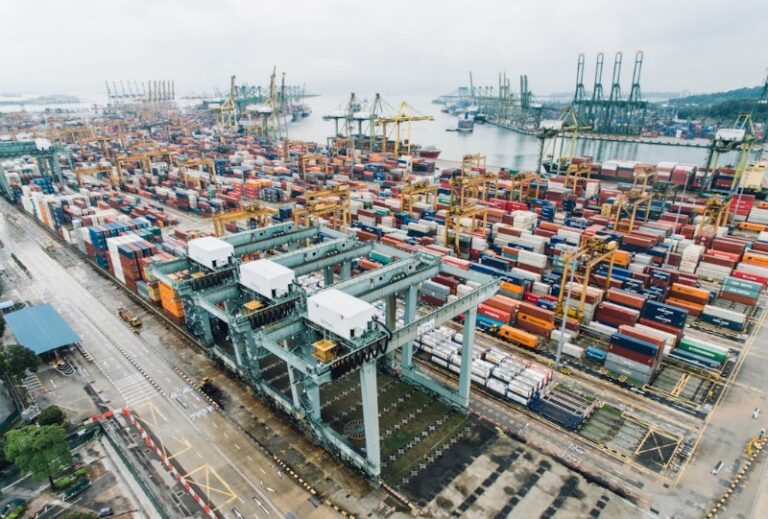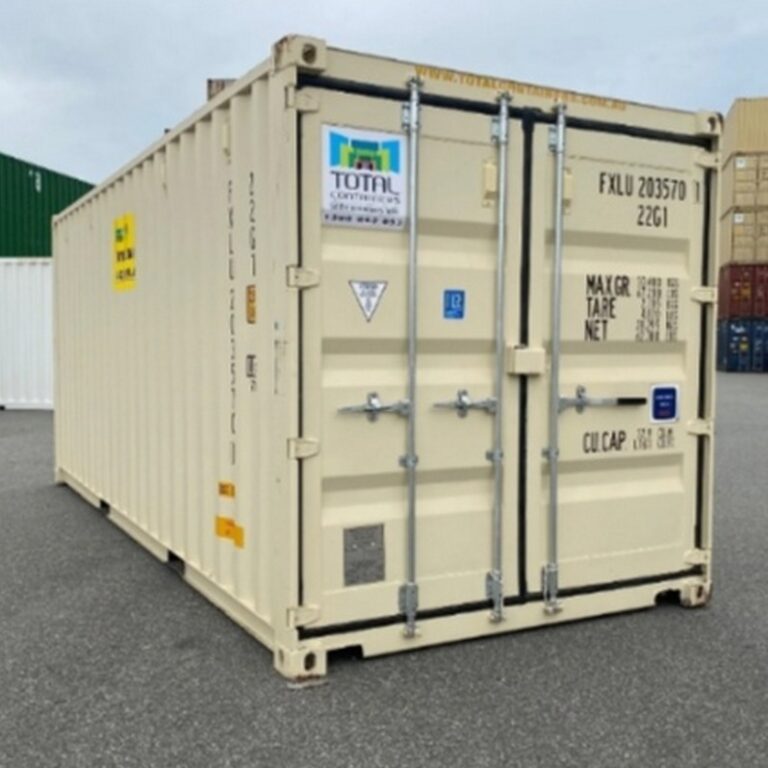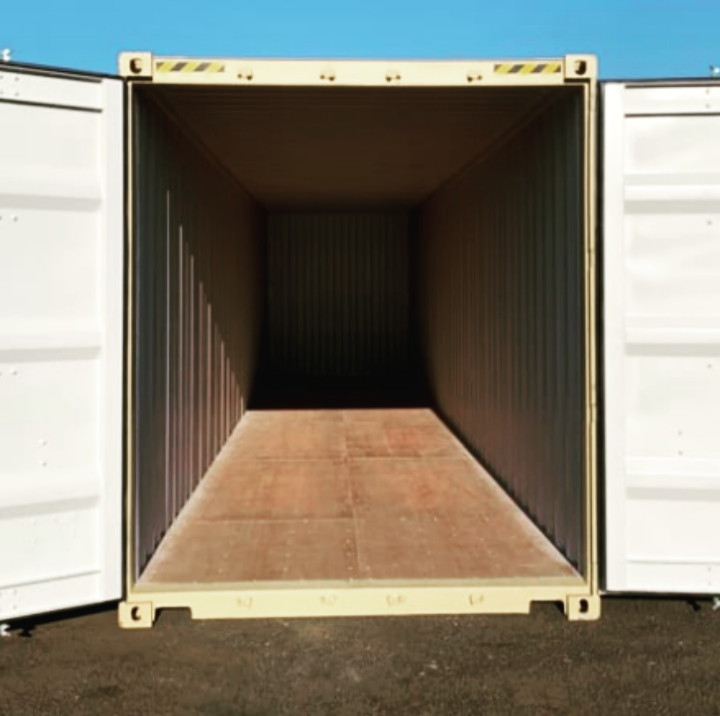Shipping Container Basics: Essential Tips You Need to Know Today
Shipping containers transport an astounding 90-95% of the world’s goods across the globe.
The world now uses over 37 million containers, making these steel boxes the foundations of global commerce. You might want to buy one for storage, build a container home, or just learn more about what they can do. Learning the simple facts about containers is vital.
These standardized steel boxes pack impressive durability and can hold 75% of their value for over 25 years! Their versatility and strength make them perfect for various uses. A standard 20-foot container hauls up to 62,170 pounds of cargo, while a 40-foot container gives you nearly 2,400 cubic feet of space.
Want to learn everything about shipping containers? Let’s explore the types, sizes, features, and what you should think about to make smart choices.

What is a Shipping Container
Shipping containers have transformed global commerce since their original debut in 1956 [1]. These reliable steel boxes are the life-blood of international trade, with approximately seventeen million containers moving cargo worldwide [2].
Basic Structure and Design
A shipping container blends durability with practicality. Built from high-strength corten steel, these containers have corrugated profiles in both roof and side walls that give them exceptional strength and rigidity. The floor uses 28mm laminated marine plywood, with cross members underneath to spread weight evenly.
Corner posts made from 10mm high-tensile steel create the structural framework. Each container needs a Container Safety Convention (CSC) plate on the left-hand door that shows owner details and technical specs. International rules require inspection every 30 months to keep the CSC certification valid [3].
These containers follow a standard design that lets cargo move between different transport methods without unloading. They must meet International Organization for Standardization (ISO) requirements to handle extreme conditions and stack uniformly on ships and trains [3].
Common Uses Today
Shipping containers now serve many purposes beyond just moving cargo. Their flexibility has sparked creative uses in many sectors:
Residential Applications:
Homes and guest houses
Student housing
Vacation homes and tiny houses
Home offices and art studios [4]
Commercial Spaces:
Pop-up shops and cafes
Office buildings and shared workspaces
Equipment storage
Food processing units [5]
Community and Public Use:
Emergency medical facilities
Lab spaces
Art galleries
Schools
Sports venues, like Ohio’s Obetz Stadium Plaza with its 122 shipping containers [5]
Military organizations lead the way in reusing these containers. They turn them into offices, sleeping quarters, kitchens, and storage buildings at bases everywhere [5]. These containers work especially well in wildfire-prone areas because they don’t burn [5].
People love shipping containers for good reasons. They last long and stand up to harsh weather [4]. Businesses can expand them easily as they grow [4]. Many places call them ‘accessory structures,’ which might not need building permits [4].
Building with shipping containers has clear advantages. Modifying them off-site cuts labor costs and speeds up construction [5]. Their strength lets builders stack them up to five stories high [5]. Yet builders must think carefully about changes like adding windows or doors and reinforce these openings properly [5].
These versatile boxes now serve unique purposes in indoor farming, sustainable agriculture, and creative furniture design [4]. Their standard size and tough build make them perfect for keeping valuable equipment safe [4].
Understanding Container Sizes
Shipping container dimensions are the life-blood of global trade. About 90% of the world’s container fleet consists of “dry freight” or “general purpose” containers [6].
Standard Container Dimensions
The 20-foot and 40-foot lengths dominate the market and make up about 80% of containers worldwide [6]. A standard 20-foot container has internal dimensions of 19’4″ x 7’8″ x 7’9″ [2] and gives you 1,172 cubic feet of space. The 40-foot container measures 39’5″ x 7’8″ x 7’10” [2] inside and provides 2,350 cubic feet of storage capacity.
You can get 10-foot containers as a compact option with internal dimensions of 9’3″ x 7’8″ x 7’10” [2]. These smaller units give you 563 cubic feet of space [7] and work great for limited storage needs.
Which Size Fits Your Needs
Your specific requirements will determine the right container size:
20-foot Containers:
Work best with heavy cargo like minerals, machinery, and steel coils [2]
Give you optimal weight distribution for dense materials
Need 100 feet of straight-line space for delivery [2]
Offer about 150 square feet of usable space [2]
40-foot Containers:
Perfect for bulky cargo like furniture and steel pipes [2]
Need 120 feet of straight-line space for placement [2]
Give you roughly 300 square feet of interior space [2]
Cost just 30% more than a 20-foot unit despite double capacity [6]
10-foot Containers:
Great for small-scale storage solutions
Work well as construction site offices
Make excellent pop-up shops
Need minimal delivery space [7]
Height Options Available
Container heights come in two standard types: regular and high cube. Standard containers stand 8’6″ (2.59m) tall externally [5] with about 7’10” of internal height [2].
High cube containers add an extra foot of height and are becoming more popular:
Stand 9’6″ (2.90m) externally [6]
Give you 8’10” of internal height [2]
Make up almost 50% of the world’s maritime container fleet [6]
Keep similar length and width dimensions as standard containers
Cost the same or sometimes less than standard units [3]
Your cargo requirements will help you choose between standard and high cube containers. High cube containers work great for taller items and give better air circulation [2]. These units are particularly useful for furniture transport and storage, which explains why they’re becoming more popular in international shipping [5].
Major coastal depots in Los Angeles, Houston, Miami, New York, and Chicago usually stock all container sizes [8]. Inland locations like Denver and Las Vegas might have fewer options [8]. Your location plays a big role in container availability.


Key Features to Check
A thorough check of the core features will give your shipping container lasting value and functionality. The resilient door mechanisms and weather sealing are vital elements you should learn about to make smart decisions.
Door Mechanisms
The door system is a vital part of every shipping container. Each door needs four to five hinges that line up perfectly so it works smoothly [9]. A well-designed door handle with extra length makes it easy to open and close the container [9].
The standard setup has:
Two doors that open outward to 270 degrees
Vertical locking bars with cam keepers
Heavy-duty forged steel hinges
EPDM rubber door gaskets
Floor Strength
The flooring system needs special attention because it directly affects how much weight the container can hold. A standard container floor has 28mm marine-grade plywood fixed to steel cross-members about every 16 inches apart [9].
Weight limits change based on container size:
20-foot containers: Maximum floor load of 4.5 tons per running meter [4]
40-foot containers: Maximum floor load of 3.0 tons per running meter [4]
Forklift operations must meet these requirements:
Maximum front axle load (including cargo): 5,460kg
Minimum tire contact area: 142 cm²
Minimum tire width: 180mm
Minimum wheel spacing: 760mm [4]
Weather Sealing
Weather sealing protects your cargo from the elements. High-quality EPDM rubber door gaskets block moisture, insects, and debris effectively [9]. These seals work best with regular maintenance and occasional replacement [10].
Weather sealing’s main features are:
Watertight door seals that stop leaks
Good insulation against temperature changes
Ventilation systems that prevent condensation
Regular seal integrity checks
The sealing system flexes well along container doors and edges, and keeps working through many opening and closing cycles [10]. Containers are made from weather-resistant Corten steel, but extra protective coatings help fight moisture and control heat transfer [11].
Security Elements
Today’s shipping containers come with several security features to protect your contents. Each door has locking clasps, but adding more security measures is often a good idea [12].
Advanced security options include:
Lock Boxes
Made from hardened steel
Hide padlocks from tampering
Stop bolt cutters
Handle bad weather [1]
Crossbar Locks
Clamps that extend and attach to door
Fix to locking rods or handles
Resist lockpicking attempts
Easy to install [1]
Inner Bolt Locks
Mount inside the container
Slide across door’s interior
Block outside access
Boost security level [1]
Your security features need regular upkeep. Check door parts often for rust, damage, or misalignment that might compromise security [1]. Using multiple security layers works best – combine physical locks with electronic monitoring systems for complete protection [1].
Evaluating Container Condition
Your choice between new and used shipping containers will affect how long your investment lasts and how well it works. You’ll make better decisions when you know the different container conditions and what they mean for your needs.
New vs Used Options
New one-trip containers are in perfect condition with very little wear since they’ve only made one trip from their overseas manufacturer [13]. These containers are usually less than a year old and look brand new because they haven’t been exposed to harsh marine environments or container depot conditions [13].
New containers give you several benefits:
Perfect interior and exterior conditions
Lock boxes installed at the factory
Perfect for sensitive cargo like medical supplies
Better protection for electrical equipment [13]
Used containers are an affordable way to get both function and value [13]. These units typically come from international shipping services and are 8-12 years old [13]. You’ll notice these features on the outside:
Different colors and shipping logos
Small dents and scratches
Oxidation marks where steel is exposed [13]
Refurbished containers offer a middle ground that extends their life and looks better [14]. Your choice between new and used containers usually comes down to:
What you’ll use it for (storage vs. modifications)
Your budget
How it needs to look [14]
Inspection Checklist
A full inspection will give you a container that meets your needs. Here are the key areas to check:
Exterior Assessment:
Look for visible damage, rust, and corrosion
Make sure doors, locks, and seals work properly
Check the overall structure and framework [6]
Interior Evaluation:
Check there are no odors or contaminants
Look for damage and pest signs
Make sure wooden flooring has no rot, decay, or water damage [6]
The roof needs special attention during inspection. Look for:
Dents, holes, or rusty areas
Proper sealing around vents and joints
Gaps in sealant materials [6]
When checking documentation, find the CSC plate with:
Unique serial number
Size specifications
Maximum gross weight
Manufacturing date [6]
Containers come in these condition categories:
Brand New (One-Trip):
Less than one year old
Hardly any dents/scratches
Seals perfectly with no light showing through
Never carried toxic materials [15]
Excellent Condition (Multi-Trip):
Meets IICL-5 or 6 standards
CSC plate is valid
Small dents and scratches
Often good enough for food grade cargo [15]
Cargo-Worthy:
CSC certification is valid
At least 50% of interior is mark-free
Minor floor delamination
Good for shipping cargo [15]
Wind and Water Tight (WWT):
Usually 10-15 years old
Lots of markings and corrosion
Floor shows significant wear
Might not have CSC plate [15]
Regular checks help maintain your container’s value and keep insurance valid [15]. Getting the full picture helps you spot problems early before they become major issues and helps your container last longer.
Cost Factors to Consider
You need to make an informed decision about shipping container acquisition by thinking over various financial aspects. These cost elements will give you the tools to plan your budget and avoid surprises.
Purchase vs Rental Pricing
Your long-term needs and financial situation determine whether you should buy or rent a shipping container. A used 20-foot container ranges from USD 1,500 to USD 3,000 [16] and offers a permanent storage or modification solution. Rental prices start at USD 75 to USD 100 monthly [8], which works better for temporary projects.
For rental agreements:
Contract periods usually run 12 to 18 months
Total rental costs range from USD 900 to USD 1,800 [8]
Rental companies handle maintenance
Perfect for short-term projects without long-term commitments
For purchases:
New containers cost more but come in pristine condition
Used containers fit tighter budgets
One-trip containers strike a balance between quality and cost
Services like Klarna help spread out upfront costs [8]
Delivery Expenses
Transportation costs are the foundations of your container budget. Local delivery usually costs USD 1.50 to USD 3.00 per mile [17]. Several factors affect the final price:
Distance and Location:
Short-distance moves (under 200 miles): USD 600 to USD 1,200 [18]
Long-distance shipping often costs too much
Your distance from ports affects pricing
Remote locations mean higher transport fees
Additional Delivery Considerations:
Crane services: USD 1,500 to USD 4,000 per operation [18]
Site preparation needs
Access limits
Unloading equipment requirements
Additional Modifications
Custom changes to your container need careful budget planning. Simple modifications start at USD 3,000 to USD 5,000. More complex changes can cost between USD 10,000 and USD 20,000 [19].
Common Modification Costs:
Structural reinforcement: USD 1,500 to USD 3,000 [3]
Insulation systems: USD 800 to USD 3,000 [3]
Utility installations: USD 3,000 to USD 5,000 [3]
Foundation work: USD 1,000 to USD 3,000 [19]
Your modification’s complexity affects material and labor costs. Simple foundations like concrete piers cost less than engineered solutions [19]. Utility installations vary based on needs, and complete systems with solar panels can reach USD 10,000 [19].
Permits and building codes add USD 500 to USD 6,000 [19] to your budget. These compliance costs change based on location and project size. Architects and engineers ensure proper modifications but add to the overall cost.
Businesses should look at tax benefits and depreciation advantages. You can spread costs across multiple budget cycles by customizing containers over time. Branded containers also add marketing value for commercial ventures [20].
Budget for ongoing maintenance:
Rust prevention treatments
Paint touch-ups
Security system upkeep
Regular inspections
Weather seal replacements
Container investments go way beyond the original purchase or rental price. A realistic budget comes from evaluating these cost factors carefully. This helps you account for all expenses without financial surprises.
Essential Safety Guidelines
Safety should be your top priority when using shipping containers. This protects both valuable cargo and human lives. Guidelines about ventilation and loading limits are the life-blood of responsible container usage.
Proper Ventilation
Good ventilation is a vital part of keeping shipping containers and their contents safe. Standard containers have two to four small vents on opposite walls, but that’s not enough for all uses [21]. Better ventilation can substantially improve how long your container lasts and what you can use it for.
Benefits of Improved Ventilation:
Temperature Regulation: Extra ventilation stops too much heat from building up that could harm sensitive items [21].
Humidity Control: Good airflow keeps humidity down and protects goods from moisture damage [21].
Fume Dissipation: Good air movement stops dangerous fumes and odors from collecting [21].
Ventilation Options:
Natural/Passive Vents: Wind moves the air through these vents, which you can add for better airflow [21].
Active/Forced Vents: Electric-powered vents push air in and out. They give you better control over temperature and humidity [21].
Some special uses like engine or battery testing need industrial fans up to three feet wide. These help remove fumes, heat, and moisture [2].
Temperature Control
The right temperature inside shipping containers keeps cargo safe and creates good working conditions. This becomes even more important when containers house people or delicate equipment.
Climate Control Considerations:
Insulation: Good insulation helps control inside temperatures. Spray foam insulation works best because it resists heat transfer [2].
HVAC Systems: You can choose from wall-mounted PTAC units to two-ton industrial air conditioners based on your container’s size and use [2].
Dehumidifiers: These protect items like rare books or manuscripts that moisture can damage [2].
Containers with industrial computer systems or other heat-sensitive equipment need advanced climate control to prevent breakdowns and protect valuable gear [2].
Specialized Temperature Control:
Harsh environments might need multiple layers of spray foam insulation on all container sides [2]. Industrial uses like 10-shower locker rooms often need several heavy-duty HVAC units to stay comfortable [2].
Loading Limits
Loading limits keep shipping containers structurally sound and safe to move. Putting too much weight in them leads to fines, liability claims, and damaged equipment [7].
Standard Weight Limitations:
20′ dry container: Maximum payload of 62,390 lbs (28,300 kg) [5]
40′ standard container: Maximum payload of 63,650 lbs (28,870 kg) [5]
40′ high cube container: Maximum payload of 63,250 lbs (28,690 kg) [5]
Note that these numbers show container capacity, not legal road weight limits. U.S. highways usually limit total weight (truck, chassis, and loaded container) to 80,000 lbs (36,287 kg) [22].
Weight Distribution:
Spreading weight evenly matters as much as total weight limits. Uneven loads can break axle weight rules and make containers unstable during transport [22]. Here’s what works best:
Spread cargo evenly throughout the container
Don’t put heavy items all in one spot
Load bars or bracing can secure cargo better
Certification Requirements:
Since April 9, 1997, containers moving by truck on U.S. highways with cargo over 29,000 lbs need certification [7]. Carriers must get this certification before accepting containers for intermodal transport.
Special Considerations:
Seasonal Weight Restrictions: Road protection during spring thaw means lower weight limits in some areas [7].
Overweight Permits: Some states let you carry more weight with special permits, but these cost extra and need special handling [7].
Equipment-Specific Limits: Different containers and chassis setups have their own weight limits. Refrigerated containers usually carry less because cooling equipment adds weight [5].
These safety guidelines help your shipping container last longer, keep cargo safe, and meet legal requirements. Safety creates a secure space for both goods and people who work with these versatile steel boxes.
Conclusion
Shipping containers are durable and versatile assets that work well for many applications. The right knowledge about container types, sizes, and key features helps you make smart decisions about your investment.
A full assessment of container conditions, cost factors, and safety standards makes a difference. These steel boxes can serve you well for decades if you pick the right unit and maintain it.
Your shipping container experience depends on good research and planning. Figure out your specific needs first, set your budget, and check local regulations. New or used containers will give you great value and last longer with proper inspections and care.
FAQs
What is the best foundation for a shipping container?
Steel piers are considered the optimal foundation for shipping containers. These posts are driven into the ground at the four corners where the container will be placed, providing a stable and durable base.
Are there items that should not be stored in shipping containers?
Yes, several items should not be packed in shipping containers, including live animals or plants, food and alcohol, hazardous materials, important documents, sentimental items, keys and small electronics, and motor vehicles or engines.
How do shipping container sizes differ?
The most common sizes are 20-foot and 40-foot containers. A standard 20-foot container offers about 150 square feet of usable space, while a 40-foot container provides approximately 300 square feet. There are also 10-foot containers for smaller storage needs and high cube options that offer an extra foot of height.
What are the key features to check when inspecting a shipping container?
When inspecting a shipping container, focus on the door mechanisms, floor strength, weather sealing, and security elements. Check for smooth door operation, examine the floor’s load-bearing capacity, ensure proper weather sealing to protect against moisture and debris, and verify the presence of adequate security features like locking clasps.
How much does it typically cost to buy or rent a shipping container?
The cost of a used 20-foot container generally ranges from $1,500 to $3,000 for purchase. Rental options typically start from $100 to $200 per month. New containers are more expensive but offer pristine condition. Additional costs to consider include delivery expenses, which can range from $600 to $1,200 for short-distance moves, and any desired modifications.
References
[1] – https://universal-containers.com/news/how-to-secure-a-shipping-container/?srsltid=AfmBOooiZ0u8YcHRUn1IVubDRbpQUKI9RaY-V_UQZB0TxaWSc3zzHCcy
[2] – https://www.falconstructures.com/blog/shipping-container-ventilation
[3] – https://oasisengineering.com/2023/08/31/budgeting-your-diy-shipping-container-home-project/
[4] – https://www.kline.com/compliance/container-floor-load-limits.html
[5] – https://www.maersk.com/support/faqs/cargo-weight-limit
[6] – https://vanislecontainers.com/blog/how-to-inspect-a-used-shipping-container-before-purchase/
[7] – https://www.oocl.com/usa/eng/localinformation/operationalrestrictions/pages/default.aspx
[8] – https://boxhub.com/resources/buying-or-renting-shipping-container-guide?srsltid=AfmBOooai2y5w7ArSt6M_SV4KTceapztFeEu1-OkohxjNH6NBoF2cZqD
[9] – https://getsimplebox.com/key-features-parts-of-container/
[10] – https://seashorerubber.com/blog/shipping-container-door-seals-fundamentals-and-replacement-guide/
[11] – https://landcontainers.com/effective-weather-proofing-strategies-for-shipping-containers/
[12] – https://containertech.com/container-modifications/locking-mechanisms/
[13] – https://containertech.com/articles/new-one-trip-vs-used-containers-which-is-right/
[14] – https://www.jakecontainers.com/new-vs-used-shipping-containers/
[15] – https://www.container-xchange.com/blog/container-conditions/
[16] – https://containerking.com/budgeting-for-your-new-shipping-container/
[17] – https://omnilogistics.com/how-much-does-it-cost-to-transport-shipping-containers/
[18] – https://www.containermovers.com/about-container-movers/how-much-does-it-cost-to-transport-or-move-a-shipping-container
[19] – https://onsitestorage.com/analyzing-the-shipping-container-conversion-cost/?srsltid=AfmBOopeoTVc7JXTqaFXazO7GnqOc3rLjIdanc0hojTW3ZsKav_Z-mYa
[20] – https://www.supercubes.com/blog/renting-vs-buying-shipping-containers
[21] – https://containersalesgroup.com/blog/the-secrets-to-proper-shipping-container-ventilation/
[22] – https://www.technogroupusa.com/size-and-weight-limit-laws/
Get quote!

No strings attached 💯